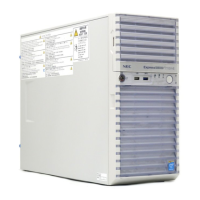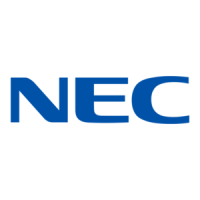How to fix 'Date/Time not set' on NEC Server?
- AAmanda RodriguezSep 3, 2025
To resolve the 'Date/Time not set' error on your NEC Server, activate the BIOS SETUP utility to set the date and time.




How to fix 'Date/Time not set' on NEC Server?
To resolve the 'Date/Time not set' error on your NEC Server, activate the BIOS SETUP utility to set the date and time.
How to fix 'External Cache Failure' on NEC Server?
If you encounter the 'External Cache Failure' or 'Cache memory bad' error on your NEC Server, ensure that you install the CPU (processor) correctly. If the issue persists, contact your service representative to replace the CPU.
What to do if NEC Server shows 'Processor 1 failed initialization on last boot'?
If your NEC Server shows 'Processor 1 failed initialization on last boot', securely install the processor. If the message appears every time you boot the system, contact your service representative to replace the processor or system board.
How do I resolve 'Insufficient Memory to Shadow PCI ROM' on NEC Server?
If you see 'Insufficient Memory to Shadow PCI ROM' on your NEC Server, for PCI boards that don't need to be bootable, use the BIOS SETUP utility to disable extension of the expanded ROM on the PCI board. Also, ensure the PCI boards and PCI riser card are securely installed. If problems persist, contact your service representative to replace the PCI board, system board, or PCI riser card.
How to troubleshoot PCI Error on NEC Server?
To resolve a 'PCI Error' on your NEC Server, ensure that the PCI boards and PCI riser card are securely installed. If the problem persists, contact your service representative to replace the PCI board, system board, or PCI riser card.
How to fix 'System Memory Size Error' on NEC Server?
To address the 'System Memory Size Error' on your NEC Server: 1. Ensure that you install the DIMMs correctly. 2. Check if all the installed DIMMs are under the same specification. If the issue continues, contact your service representative to replace the DIMMs.
What to do if NEC Server shows 'Keyboard Interface Error'?
If you encounter the 'Keyboard Interface Error' on your NEC Server, try reconnecting the keyboard. If the issue persists, contact your service representative to replace the system board.
What to do if NEC Server displays 'Keyboard Stuck Key'?
If your NEC Server displays a 'Keyboard Stuck Key' error, try releasing the key that is stuck. If the problem persists, contact your service representative to replace the system board.
What to do if NEC Server shows 'Insert Key Pressed'?
If you encounter the 'Insert Key Pressed' error on your NEC Server, first release the key that is pressed. Then, try reconnecting the keyboard to ensure it is properly connected.
How to resolve 'CMOS Checksum Failure' on NEC Server?
If you're getting a 'CMOS Checksum Failure' error on your NEC Server, execute SETUP to correct the setting.
Federal communication commission radio frequency interference statement.
Statement regarding Class A product and domestic environment interference.
Classification as CLASS 1 LASER PRODUCT and label location.
Information on UL Listed label and CE label for exported equipment.
Classification of equipment and software under Foreign Exchange and Foreign Trade Act.
General precautions for safe server use, including warnings about critical applications.
Definitions for hazard, prohibited action, and mandatory action symbols.
Notes on server installation, including rack mounting and environmental considerations.
Instructions for connecting interface cables and power cords, emphasizing safety.
Steps for unmounting the server from the rack and relocating it safely.
Explanation of text conventions used in the guide, including IMPORTANT and NOTE.
Guidance on finding information quickly within the manual's structure.
Overview of server features including high performance, reliability, and expandability.
Details on the differences and configurations of A1080a-S, A1040a, A1080a-D, and A1080a-E models.
Description of server management functions, including hardware and software components.
Configuration of various server operation modes like DVD/USB, Power, and Maintenance.
Settings related to OS, Boot, Memory, Processor, I/O, Stall Monitoring, Fault Handling, Security, and Other.
Identification and description of server components including external and internal views.
Procedures for installing the server in a rack and connecting peripherals.
Describes basic server operations like power-on, booting, and handling DVDs.
Information on installing or removing internal optional devices and notes on their usage.
Functions for controlling server power, checking system status, and setting networks.
Guide to setting the Basic Input Output System (BIOS) for server configuration.
Procedures for using internal hard disk drives as a RAID system.
Control and monitoring of the server from a remote location via web browser.
Remote operation and status check of the management server, even when OS is not running.
Procedures for resetting the server and clearing internal memory (CMOS).
Introduction to bundled software, utilities, online documents, and drivers on the EXPRESSBUILDER.
Description of the setup tool for server maintenance and installation.
Introduction to software bundled for installation on the server, including OS and utilities.
Description of software bundled for management PC for server monitoring and management.
Checking points for daily use, file management, and server cleaning.
Guidance on identifying and resolving server failures, including error messages and LED indications.
Procedures for using the dedicated diagnostic utility for the server.
Procedures and cautions for relocating or storing the server safely.
Detailed specifications for Intel® Xeon® E7-8800/4800 processors.
Detailed specifications for Intel® Xeon® Processor 7500 series.
List of error numbers and their descriptions for system diagnostics.
Descriptions of API status codes (ATA Command and ATA IO).
Descriptions of SCSI Target status codes.
Descriptions of SCSI Host status codes.
Descriptions of SCSI Driver status codes.
List of sense codes (KEY/ASC/ASCQ) and their descriptions.
Table detailing BIOS settings for Windows, Linux, and VMware OS.
License agreement terms and conditions for copying, distribution, and modification.












